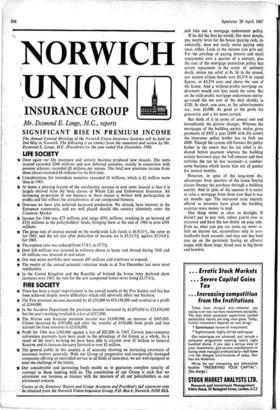Loan, sweet loan
CONSUMING INTEREST LESLIE ADRIAN
We taxpayers are a lucky lot when it comes to bricks and mortar. The April issue of the Con- sumer Council's Focus drew attention to this in an article on the Government's option- mortgage plan, which will come into operation on 1 April next year. The figure are reveal- ing, showing that a low income-earner paying no tax would part with £2,160 over twenty-five years for every £1,000 he borrowed on mort- gage (taking the rate of interest at its present 7+ per cent), while a standard rate taxpayer would only hand over £1,788. Under the sub- sidised option-mortgage scheme the repayments will total £1,792 per £1,000 with a subsidy of £309, evening out the present vast discrepancy between the high and low taxpayers.
Much the same gap yawns between the mort- gagee and the happy endowment assurance (with profits) policyholder at the moment (and not much is likely to change here). One example that was worked out for me by Superannuation Advisory Services can only be described as staggering. It is, of course, a 'loaded' case, in the sense that all the financial authorities agree that the middle-aged, high earner with high tax has huge advantages over the young, low earner with little or no tax. If our fictitious house- purchaser were forty-seven and looking to borrow £5,000 at 71 per cent for twenty-five years he could either go to a building society in the ordinary way or to an insurance company and take out a mortgage endowment policy.
If he did the first he would, like most people, pay nearly twice for his house (paying cash, in- cidentally, does not really mean paying only once, either. Look at the income you give up). For the privilege of paying interest and small repayments over a quarter of a century, plus the cost of the mortgage protection policy that covers repayment in the event of untimely death, minus tax relief at 8s 3d in the pound, our mature citizen hands over £9,374 in round figures, or £4,374 over and above the cost of the house. And a without-profits mortgage en- dowment would cost him much the same. But on the with-profits mortgage endowment merry- go-round the net cost of the deal shrinks to £320. In short, you save, as the advertisements say, over £4,000. As good as the pools for generosity and a lot more certain.
But think of it in terms of annual rent and immediately the picture changes. Whereas the mortgagee of the building society makes gross payments of £455 a year (£490 with life cover) the insurance policy holder has to fork out £600. Though the system still favours the policy holder to the extent that his tax relief is de- ducted before payment whereas the building society borrower pays the full amount and then reclaims the tax he has overpaid—a cumber- some business which leaves him out of pocket for several months.
However, in spite of the long-term dis- advantages three quarters of the house buying classes finance the purchase through a building society. And in spite of the squeeze it is easier to raise a mortgage from them now than it was six months ago. The increased rates recently offered to investors have given the building societies more money to lend.
One thing seems as clear as daylight. It doesn't pay to pay rent, unless you're ever so statutory and have the law firmly on your side. Even so, what you pay out earns no sweet re- liefs on income tax, accumulates only in your landlord's bank account, and may one day land you up on the pavement having an alfresco cuppa with those large, bland men in big boots and bowlers.







































 Previous page
Previous page